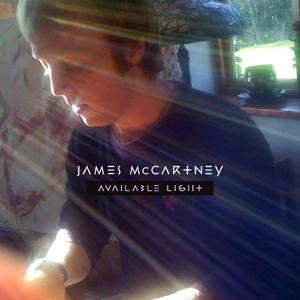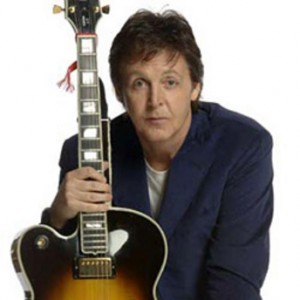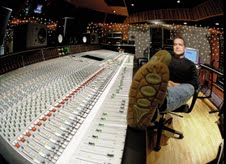James McCartney Releasing "Available Light": 5 Questions for David Kahne, Co-Producer & Mixer
HELL’S KITCHEN, MANHATTAN: With conviction like his, James McCartney doesn’t have to convince anybody of anything. Just a few seconds into “Angel”, the opening cut of his new EP, Available Light, it’s clear to all with ears that his hooks are heroic. And they’re his.
Of course, with his bloodline, James has to convince a whole ton of people that he really can play guitar and sing, much less write a song. On the one side of his heritage is Sir Paul McCartney, the Beatle who transformed Western music along with his bandmates John Lennon, George Harrison and Ringo Starr. James’ DNA springs equally from Lady Linda McCartney, a primary sonic force as Paul’s muse and partner in Wings.
That kind of family tree will trigger high expectations – probably why James McCartney has kept quiet about himself for most of his 33 years. But with the kind of natural talent he possesses on guitar and vocals, it was only a matter of time before a record would arrive.
Now, the moment is right. Available Light, co-produced by Paul McCartney and David Kahne, debuts Tuesday, September 21 on NYC’s Engine Company Records, and the sounds it holds just might shock and awe. After the instant rush of “Angel” is the driving tension of “Glisten”, the bittersweet uplift of “My Friend”, and the Cobain-dark drama of “Denial”. The capper is his band’s masterful cover of Neil Young’s “Old Man”, with the power to raise neck hairs after repeated listenings.
The New York City-based Kahne, a longtime collaborator of Paul and a wide spread of artists including Tony Bennett, Fishbone, Sublime, The Strokes, Sugar Ray, The Bangles, Sean Lennon, Stevie Nicks, Regina Spektor, Linkin Park and Mike Doughty was on hand for it all. He oversaw the recording sessions at Paul’s Hog Hill Mill Studios in Sussex, Abbey Road Studios in London, and SeeSquared Studios and Avatar Studios back here in NYC, and mixed the record.
Typically occupied with a diverse palette of projects – scoring two films, working with the NYC rock band the Dirty Pearls, developing eight other artists, and finishing an orchestral ballet of Peter Pan – Kahne granted SonicScoop a rare interview about co-producing this rarest of records.
What made you the right teammate for James McCartney and Co-Producer Paul McCartney on Available Light?
I’ve worked with Paul for 10 years, and I’ve known James for about eight years, although James and I had never worked on any music. So when Paul decided that he wanted James to get a record made, he called me up and asked if I was interested in producing James’ music with him… It was really that simple. And I immediately said yes.
Knowing James from before helped, and I’ve worked with Paul a lot so he must have felt I might be a good person to collaborate with. Paul hoped we could work together well in a triangle. So we all agreed and started working. I think he was right.
There were two recording stages for “Available Light”. The first phase saw James playing most of the instruments, and Sean Pelton on drums. Towards the end of those sessions James also formed a band with members of the Dead 60s, toured with them and re-recorded several of those tracks plus six new ones. Why was this two-phase process undertaken?
We recorded quite a bit of the first recordings in Paul’s studio (Hog Hill Mill Studios) in the south of England, in Sussex. James, Paul, and me – Paul not playing by the way, except to come up with parts, a few of which stayed as Paul’s performances. We had a great drummer from New York, Shawn Pelton, come in, but James played bass, guitar and keyboards. We got an album’s worth of songs, actually more than that, done. But we were still looking for more to choose from.
Then we talked about having a band, to see what that was like, and so that James could start playing gigs. James had played some in bands, but not that much. I had produced a band called the Dead 60s from Liverpool. I called up the drummer Bryan Johnson and the bass player Charlie Turner, connected them with James, and they started rehearsing with him. Then we brought in their friend Steve Bayley, who played guitar and keyboards.
We decided “This sounds really good, too.” We recorded a bunch of new songs, and re-recorded some of the previously recorded songs to compare them to what we already had. On Available Light the new band recorded “Old Man”. All of the other songs, “Angel,” “Glisten”, “My Friend” and “Denial” were from the older sessions, but a couple of those songs have overdubs from the new band. It’s definitely worth noting that Gil Goldstein plays accordion on “Old Man”. And Steven Isserlis plays cello on “Glisten”.
James brought in 50 cover songs to choose from, and we chose two: “Old Man” was one of the songs we decided on. We were going through the list, and when we got to “Old Man” I heard him sing the first line and I got a chill. It was a great moment.
It’s an absolutely dynamite cover of one of Neil Young’s signature creations. In the studio, how would you describe James’ approach to recording – what sound/feel was he going for with Available Light, and how did you facilitate that?
I wouldn’t say James goes for a particular sound and feel. It’s not like a directed, “This is what I want.” He kind of plays the way he plays. He’s a gifted musician who can play bass and guitar right-handed and left-handed — he can play his Dad’s bass with either hand. And he has a massive vocal range, at least three-and-a-half octaves. His guitar playing is world-class, as his hands are so sure and effortless. And his piano playing is graceful and strong. He held a note the other day for 52 seconds.
He writes the song, he feels something when he writes the song, and when he plays it, it’s done the way he felt it. So in production, the point was to make sure that was as wholly fleshed out as possible, without squashing or stepping on the original sense and feel of what he’d played. It’s very easy in the studio to run roughshod over original intentions.
The song “Denial” is very, very dark, and “Angel” is another great example, just based on what he’s feeling when he writes it. When he performs, the songs come off the way that he felt. He has a very direct connection to what he feels and what he sounds like, and actually doesn’t talk much about what the songs mean. He’s a very feeling person.
I didn’t know any of the songs when we started, and Paul hadn’t heard a lot of them. James would play them, Paul and I would sit and listen, and there were many times when we looked at each other and said, “WOW.”
On one song we were listening to for the EP, James was singing quietly and then got so loud so quickly that he hurt my ears, just singing and playing acoustically. Paul and I jumped and James said, “Was that too loud?” He can go from 0-to-60 in a second. As I understand, he’s always been like that, since he was little. He could play “The Wind Cries Mary” when he was 12. He would listen to songs and quickly be able to play them, no matter how difficult.
Moving on to the mixing. How would you describe your philosophy overall as a mixer, and then how did that guide your approach to mixing this record?
Well, I’m usually mixing while I produce, so the way I work is that by the time I get to mixing, I’m already close to my final goal, since I mixed as I went along. Which is interesting, now that I think about it, because it’s kind of Beatley – they had sub-mixes which they had made by bouncing back and forth on four tracks. Their mix parts were committed to early on.
I use a lot of analog outboard gear, but I’ve set my computers up through a MADI system so that I have access to that gear outside the computers while I’m working on the project. So I can instantly get to or recall that gear if I recall the session. If I get a vocal sound I like, using my Federal Limiter or my Fairchild, I can keep it and continue with it through the overdubs.
We started the second phase at Abbey Road, and then finished recording at Paul’s studio in Sussex, mixed the whole record, and then I came back to NYC, to my studio, and I remixed about 2/3rds of it in recall. I’m very much vocal-first: I put the vocal up first and go around that. That was a really good thing to do in James’ case – it keeps anything from getting mixed in a way that pulls away from the voice. And of course, getting the arrangement right in the first place helps.
We would redo the guitars with different voicings to draw the voice out, for example. I call that mixing, too. It’s just fixing it another way. If there’s a vocal in there, I figure that takes precedence and has to be served.
There was some serious rock royalty all over Available Light – what did you learn personally from this project, both about songwriting and recording?
It was fascinating working with Paul and James, not only as producer and artist, but as father and son. Musically, I’m always learning about the artist and his/her point of view. If they’re good, there’s something unique and distinctive there. And these recordings were no exception. I learned so much from working with James and Paul.
James’ ability as a guitar player was astounding to me. He did things I had never experienced before. He would play a really complicated guitar part, and then I’d ask him to double it on acoustic. He would do that, and it would be as if I had made a copy of the first one. He knows where every note is, and that makes for a certain kind of power in a recording – the level of precision that comes out.
It was also different working with Paul as Co-Producer, because he wasn’t playing. It was Paul and me talking about things, then the two of us talking to James. Or Paul or myself singley working with James at times. I got to work with Paul in a different way on this album. I think it worked out really well. And James shines through.
— David Weiss










Martin Bouwman
December 5, 2010 at 1:09 pm (14 years ago)It is amazing that the son can play as much different instrument as the dad….
I do like what I heard on youtube,… Has Available Light been released in the Netherlands?
I didn’t see it anywhere…
Martin Bouwman